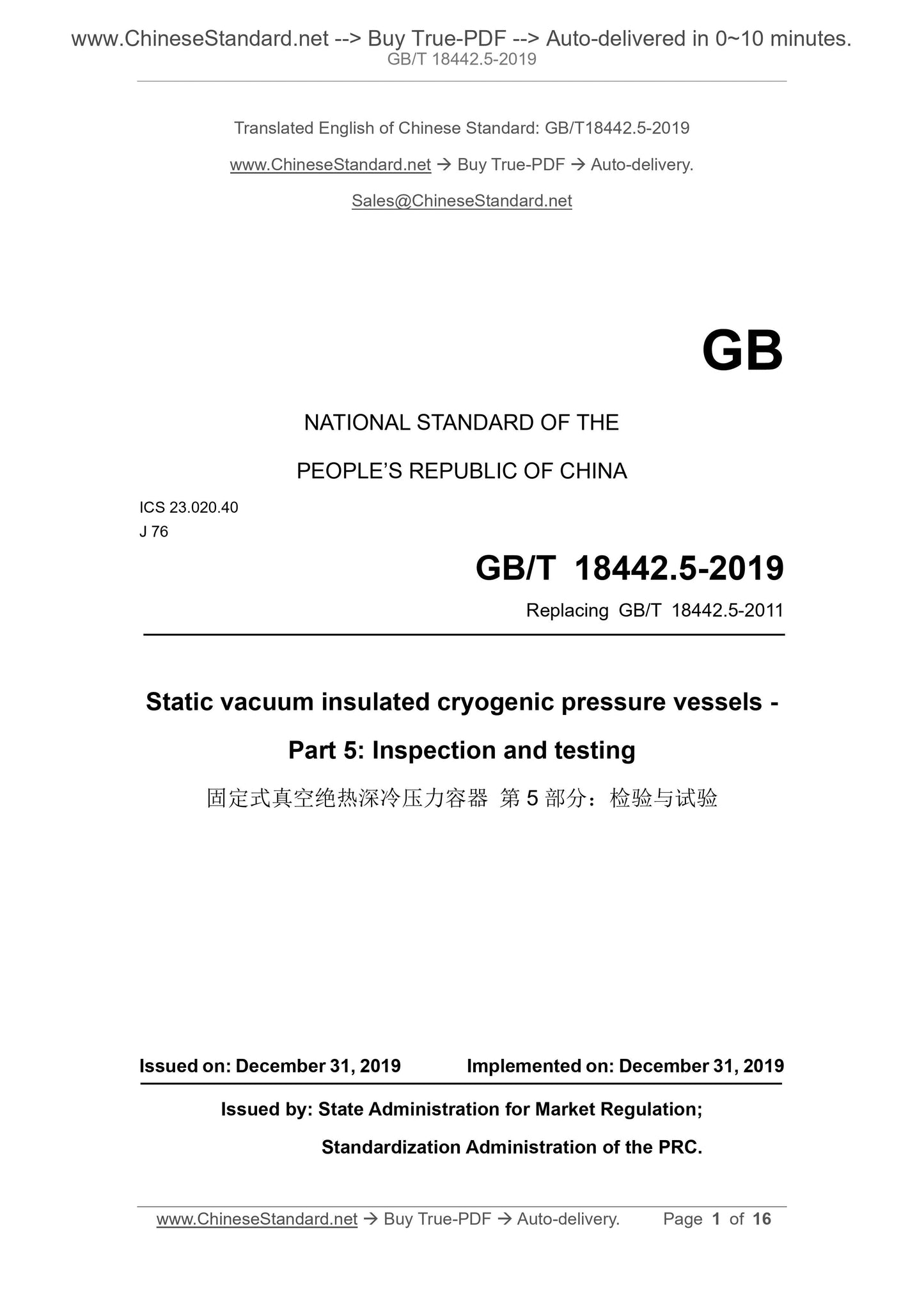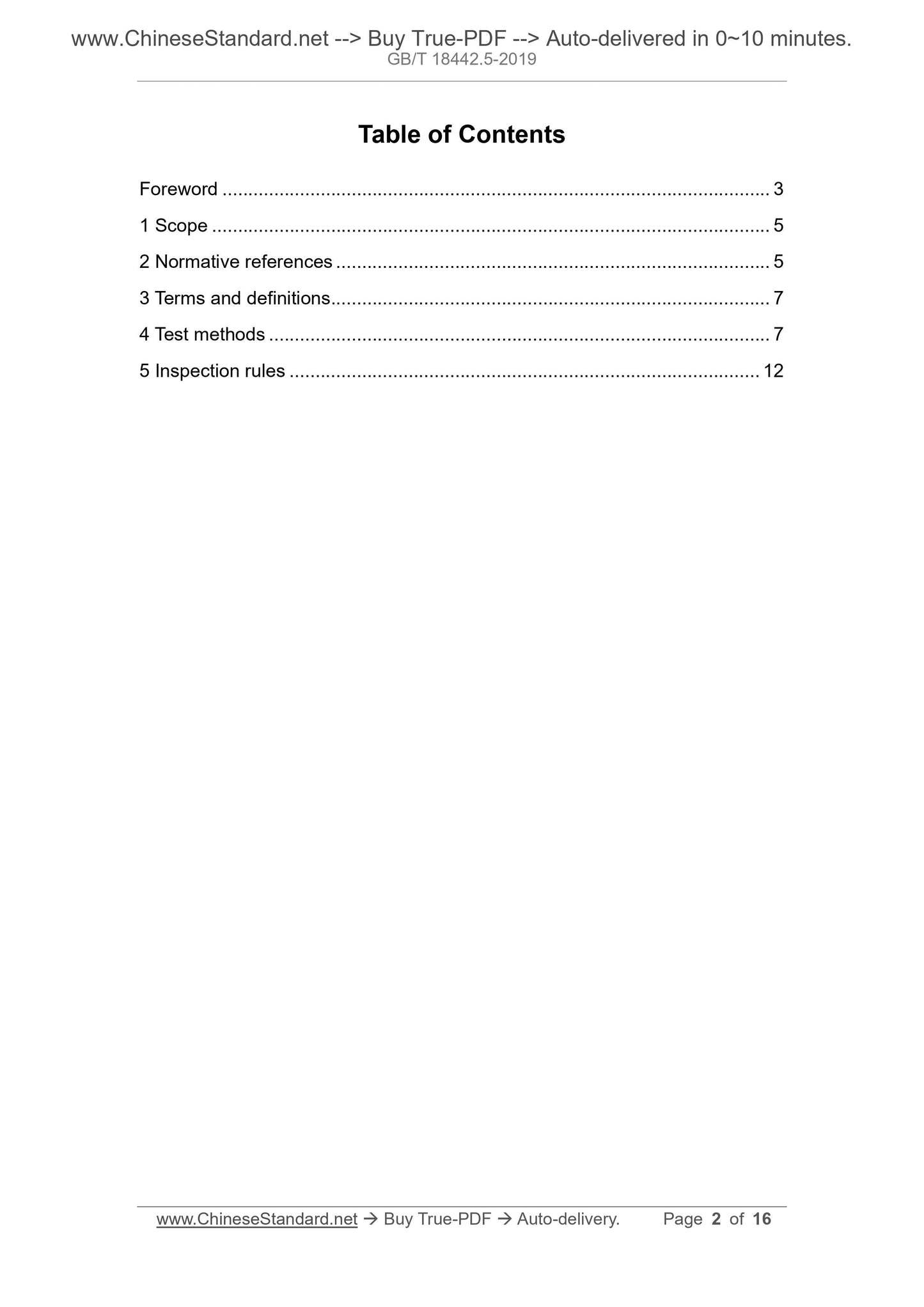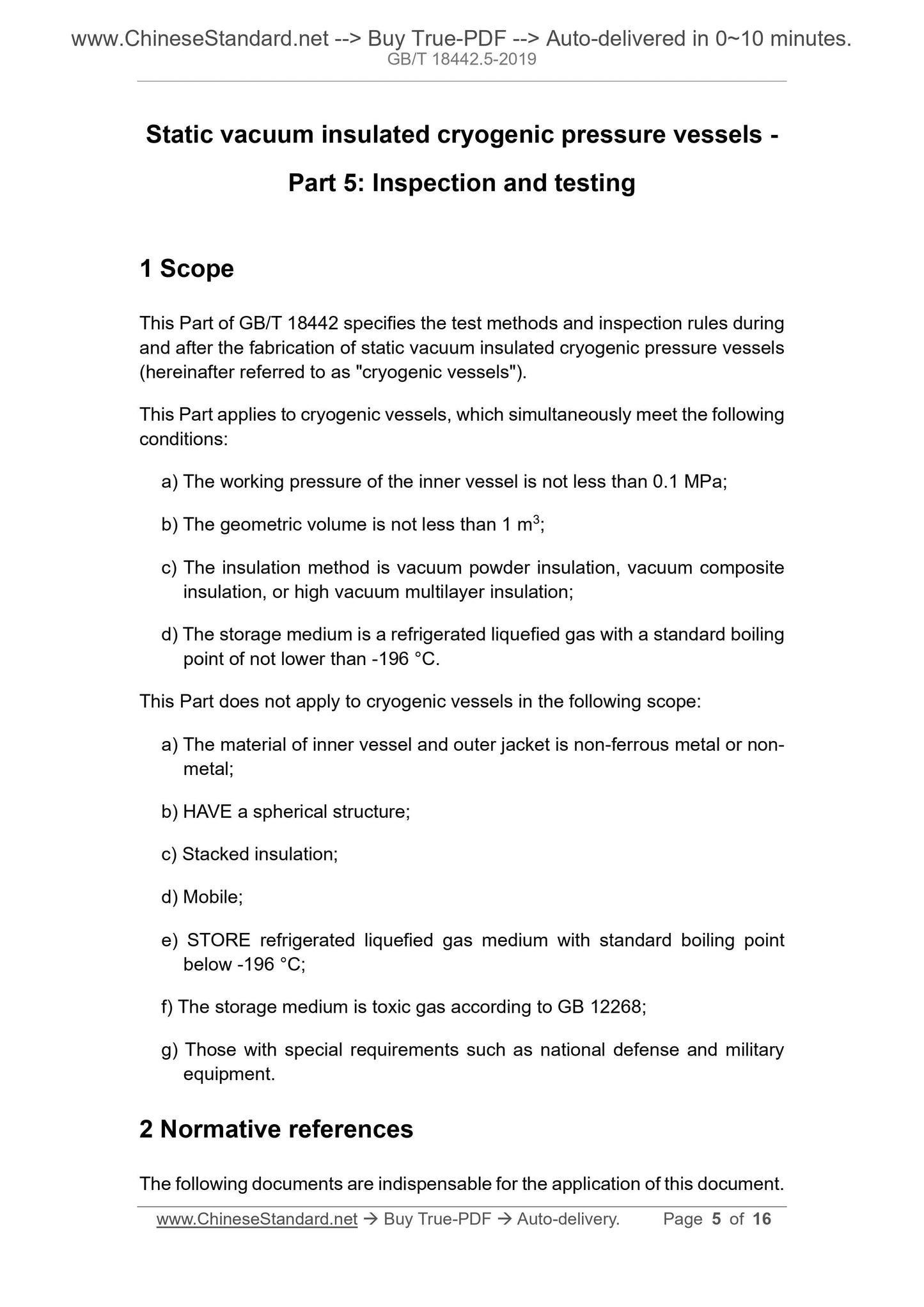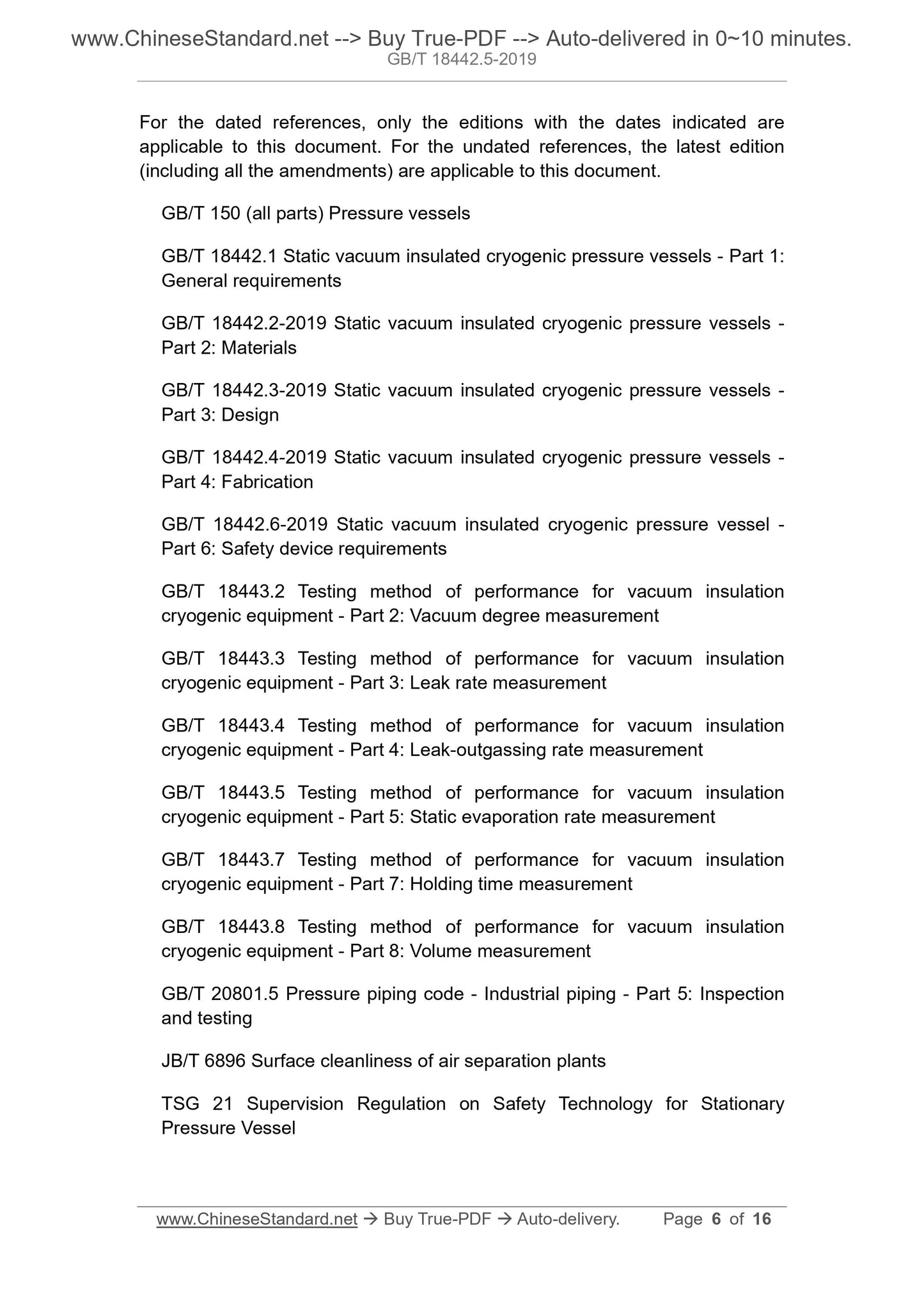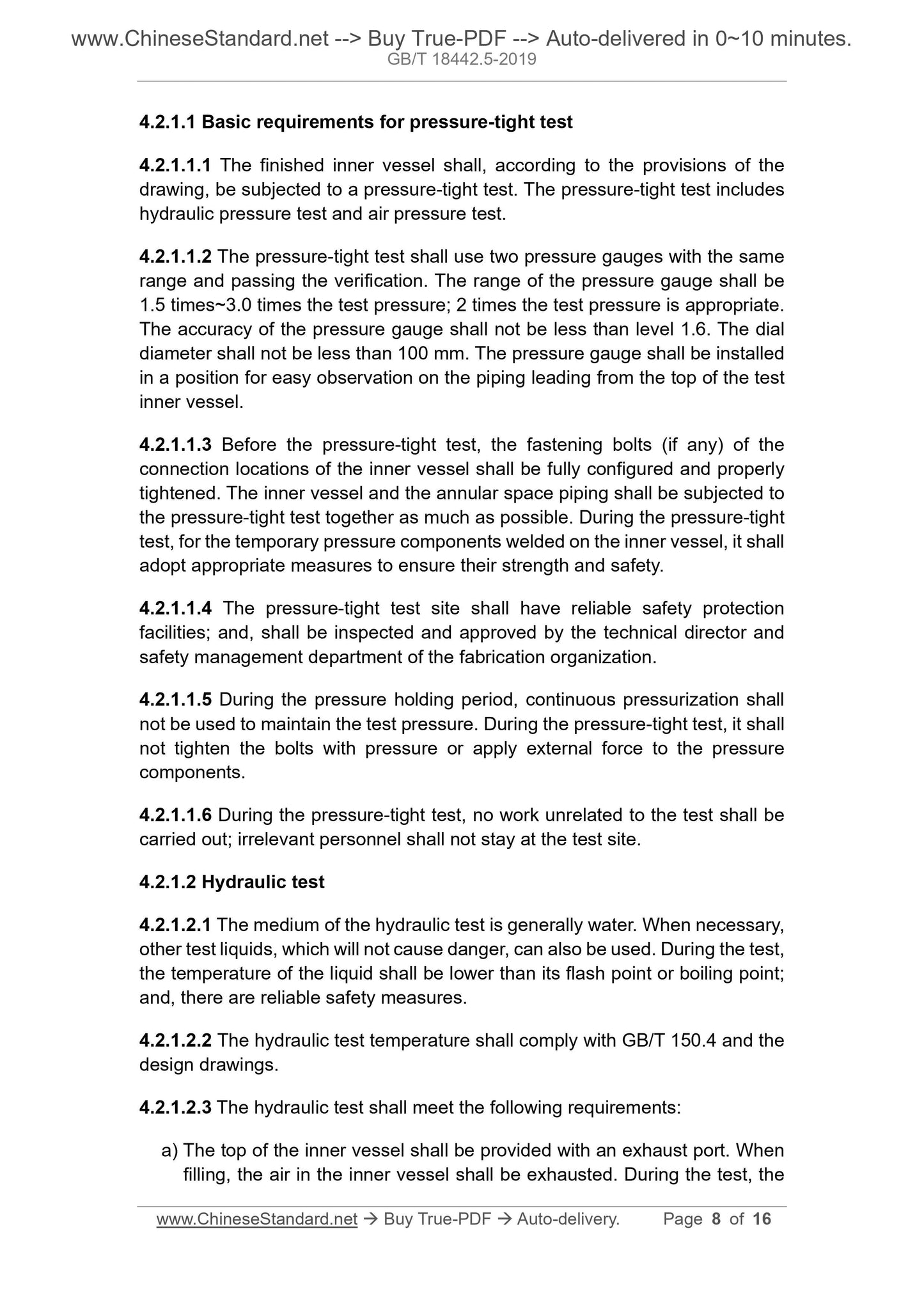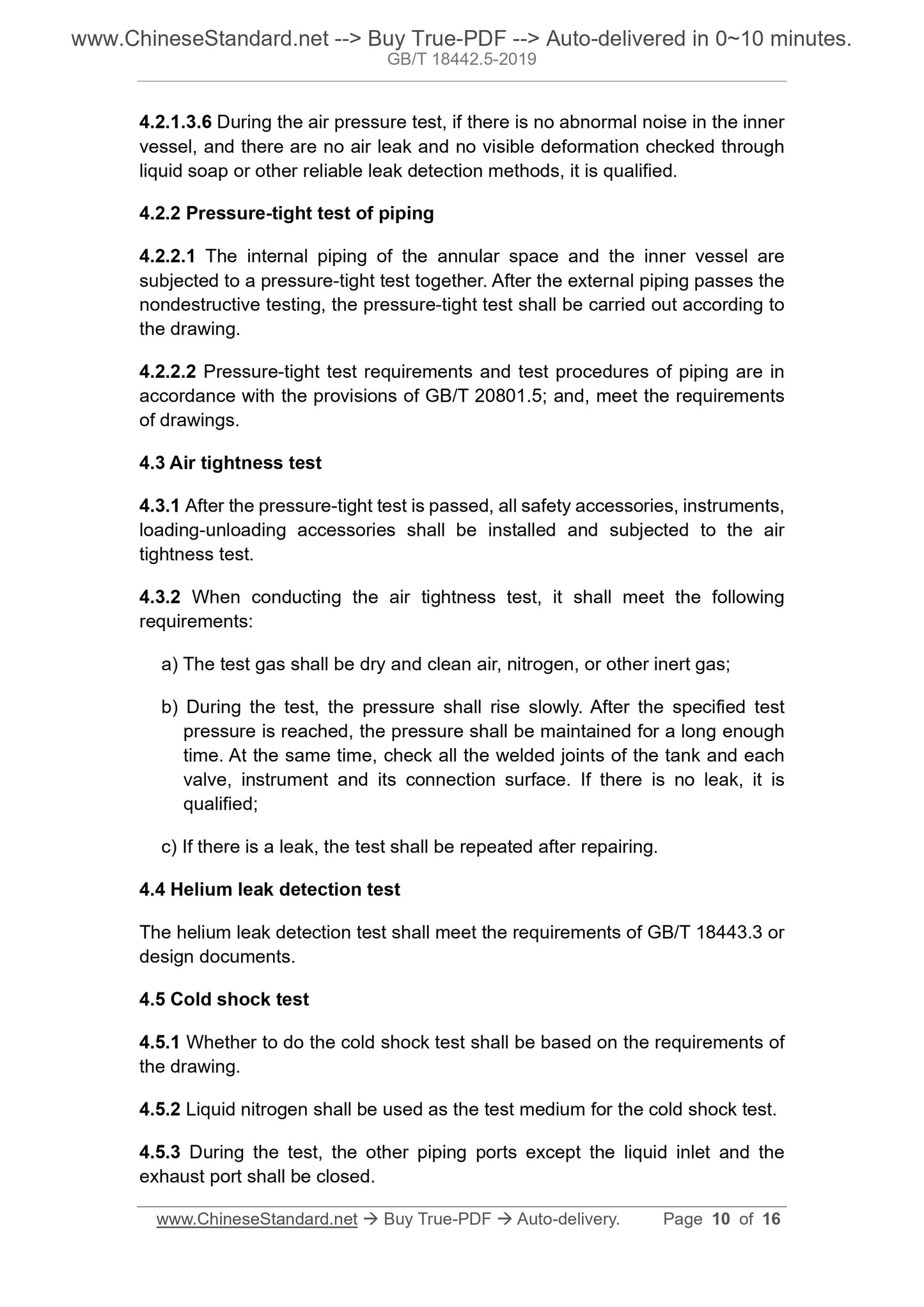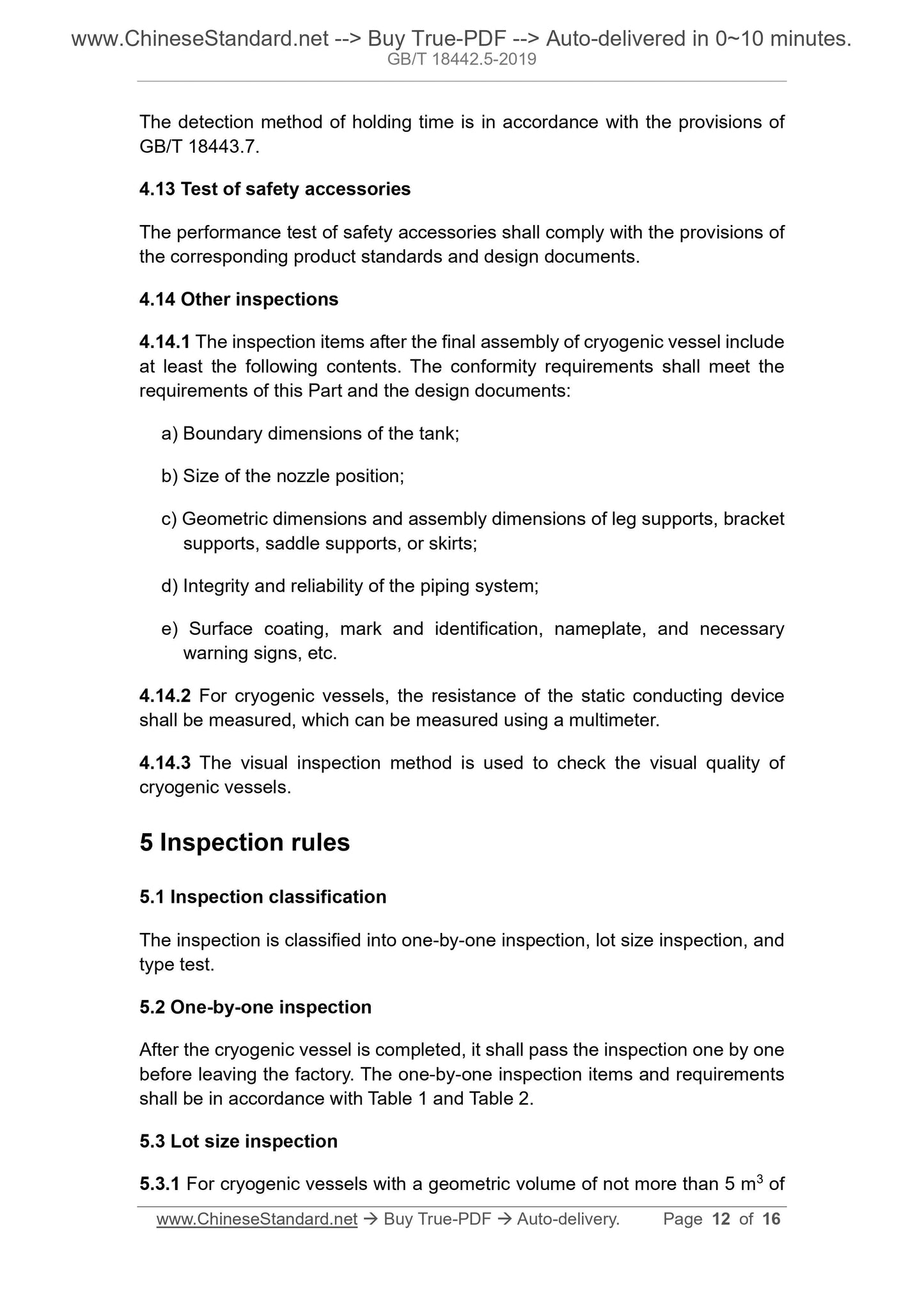1
/
of
7
PayPal, credit cards. Download editable-PDF and invoice in 1 second!
GB/T 18442.5-2019 English PDF (GB/T18442.5-2019)
GB/T 18442.5-2019 English PDF (GB/T18442.5-2019)
Regular price
$145.00 USD
Regular price
Sale price
$145.00 USD
Unit price
/
per
Shipping calculated at checkout.
Couldn't load pickup availability
Delivery: 3 seconds. Download true-PDF + Invoice.
Get QUOTATION in 1-minute: Click GB/T 18442.5-2019
Historical versions: GB/T 18442.5-2019
Preview True-PDF (Reload/Scroll if blank)
GB/T 18442.5-2019: Static vacuum insulated cryogenic pressure vessel -- Part 5: Inspection and test
GB/T 18442.5-2019
NATIONAL STANDARD OF THE
PEOPLE’S REPUBLIC OF CHINA
ICS 23.020.40
J 76
Replacing GB/T 18442.5-2011
Static vacuum insulated cryogenic pressure vessels -
Part 5: Inspection and testing
ISSUED ON: DECEMBER 31, 2019
IMPLEMENTED ON: DECEMBER 31, 2019
Issued by: State Administration for Market Regulation;
Standardization Administration of the PRC.
Table of Contents
Foreword ... 3
1 Scope ... 5
2 Normative references ... 5
3 Terms and definitions ... 7
4 Test methods ... 7
5 Inspection rules ... 12
Static vacuum insulated cryogenic pressure vessels -
Part 5: Inspection and testing
1 Scope
This Part of GB/T 18442 specifies the test methods and inspection rules during
and after the fabrication of static vacuum insulated cryogenic pressure vessels
(hereinafter referred to as "cryogenic vessels").
This Part applies to cryogenic vessels, which simultaneously meet the following
conditions:
a) The working pressure of the inner vessel is not less than 0.1 MPa;
b) The geometric volume is not less than 1 m3;
c) The insulation method is vacuum powder insulation, vacuum composite
insulation, or high vacuum multilayer insulation;
d) The storage medium is a refrigerated liquefied gas with a standard boiling
point of not lower than -196 °C.
This Part does not apply to cryogenic vessels in the following scope:
a) The material of inner vessel and outer jacket is non-ferrous metal or non-
metal;
b) HAVE a spherical structure;
c) Stacked insulation;
d) Mobile;
e) STORE refrigerated liquefied gas medium with standard boiling point
below -196 °C;
f) The storage medium is toxic gas according to GB 12268;
g) Those with special requirements such as national defense and military
equipment.
2 Normative references
The following documents are indispensable for the application of this document.
For the dated references, only the editions with the dates indicated are
applicable to this document. For the undated references, the latest edition
(including all the amendments) are applicable to this document.
GB/T 150 (all parts) Pressure vessels
GB/T 18442.1 Static vacuum insulated cryogenic pressure vessels - Part 1:
General requirements
GB/T 18442.2-2019 Static vacuum insulated cryogenic pressure vessels -
Part 2: Materials
GB/T 18442.3-2019 Static vacuum insulated cryogenic pressure vessels -
Part 3: Design
GB/T 18442.4-2019 Static vacuum insulated cryogenic pressure vessels -
Part 4: Fabrication
GB/T 18442.6-2019 Static vacuum insulated cryogenic pressure vessel -
Part 6: Safety device requirements
GB/T 18443.2 Testing method of performance for vacuum insulation
cryogenic equipment - Part 2: Vacuum degree measurement
GB/T 18443.3 Testing method of performance for vacuum insulation
cryogenic equipment - Part 3: Leak rate measurement
GB/T 18443.4 Testing method of performance for vacuum insulation
cryogenic equipment - Part 4: Leak-outgassing rate measurement
GB/T 18443.5 Testing method of performance for vacuum insulation
cryogenic equipment - Part 5: Static evaporation rate measurement
GB/T 18443.7 Testing method of performance for vacuum insulation
cryogenic equipment - Part 7: Holding time measurement
GB/T 18443.8 Testing method of performance for vacuum insulation
cryogenic equipment - Part 8: Volume measurement
GB/T 20801.5 Pressure piping code - Industrial piping - Part 5: Inspection
and testing
JB/T 6896 Surface cleanliness of air separation plants
TSG 21 Supervision Regulation on Safety Technology for Stationary
Pressure Vessel
4.2.1.1 Basic requirements for pressure-tight test
4.2.1.1.1 The finished inner vessel shall, according to the provisions of the
drawing, be subjected to a pressure-tight test. The pressure-tight test includes
hydraulic pressure test and air pressure test.
4.2.1.1.2 The pressure-tight test shall use two pressure gauges with the same
range and passing the verification. The range of the pressure gauge shall be
1.5 times~3.0 times the test pressure; 2 times the test pressure is appropriate.
The accuracy of the pressure gauge shall not be less than level 1.6. The dial
diameter shall not be less than 100 mm. The pressure gauge shall be installed
in a position for easy observation on the piping leading from the top of the test
inner vessel.
4.2.1.1.3 Before the pressure-tight test, the fastening bolts (if any) of the
connection locations of the inner vessel shall be fully configured and properly
tightened. The inner vessel and the annular space piping shall be subjected to
the pressure-tight test together as much as possible. During the pressure-tight
test, for the temporary pressure components welded on the inner vessel, it shall
adopt appropriate measures to ensure their strength and safety.
4.2.1.1.4 The pressure-tight test site shall have reliable safety protection
facilities; and, shall be inspected and approved by the technical director and
safety management department of the fabrication organization.
4.2.1.1.5 During the pressure holding period, continuous pressurization shall
not be used to maintain the test pressure. During the pressure-tight test, it shall
not tighten the bolts with pressure or apply external force to the pressure
components.
4.2.1.1.6 During the pressure-tight test, no work unrelated to the test shall be
carried out; irrelevant personnel shall not stay at the test site.
4.2.1.2 Hydraulic test
4.2.1.2.1 The medium of the hydraulic test is generally water. When necessary,
other test liquids, which will not cause danger, can also be used. During the test,
the temperature of the liquid shall be lower than its flash point or boiling point;
and, there are reliable safety measures.
4.2.1.2.2 The hydraulic test temperature shall comply with GB/T 150.4 and the
design drawings.
4.2.1.2.3 The hydraulic test shall meet the following requirements:
a) The top of the inner vessel shall be provided with an exhaust port. When
filling, the air in the inner vessel shall be exhausted. During the test, the
4.2.1.3.6 During the air pressure test, if there is no abnormal noise in the inner
vessel, and there are no air leak and no visible deformation checked through
liquid soap or other reliable leak detection methods, it is qualified.
4.2.2 Pressure-tight test of piping
4.2.2.1 The internal piping of the annular space and the inner vessel are
subjected to a pressure-tight test together. After the external piping passes the
nondestructive testing, the pressure-tight test shall be carried out according to
the drawing.
4.2.2.2 Pressure-tight test requirements and test procedures of piping are in
accordance with the provisions of GB/T 20801.5; and, meet the requirements
of drawings.
4.3 Air tightness test
4.3.1 After the pressure-tight test is passed, all safety accessories, instruments,
loading-unloading accessories shall be installed and subjected to the air
tightness test.
4.3.2 When conducting the air tightness test, it shall meet the following
requirements:
a) The test gas shall be dry and clean air, nitrogen, or other inert gas;
b) During the test, the pressure shall rise slowly. After the specified test
pressure is reached, the pressure shall be maintained for a long enough
time. At the same time, check all the welded joints of the tank and each
valve, instrument and its connection surface. If there is no leak, it is
qualified;
c) If there is a leak, the test sh...
Get QUOTATION in 1-minute: Click GB/T 18442.5-2019
Historical versions: GB/T 18442.5-2019
Preview True-PDF (Reload/Scroll if blank)
GB/T 18442.5-2019: Static vacuum insulated cryogenic pressure vessel -- Part 5: Inspection and test
GB/T 18442.5-2019
NATIONAL STANDARD OF THE
PEOPLE’S REPUBLIC OF CHINA
ICS 23.020.40
J 76
Replacing GB/T 18442.5-2011
Static vacuum insulated cryogenic pressure vessels -
Part 5: Inspection and testing
ISSUED ON: DECEMBER 31, 2019
IMPLEMENTED ON: DECEMBER 31, 2019
Issued by: State Administration for Market Regulation;
Standardization Administration of the PRC.
Table of Contents
Foreword ... 3
1 Scope ... 5
2 Normative references ... 5
3 Terms and definitions ... 7
4 Test methods ... 7
5 Inspection rules ... 12
Static vacuum insulated cryogenic pressure vessels -
Part 5: Inspection and testing
1 Scope
This Part of GB/T 18442 specifies the test methods and inspection rules during
and after the fabrication of static vacuum insulated cryogenic pressure vessels
(hereinafter referred to as "cryogenic vessels").
This Part applies to cryogenic vessels, which simultaneously meet the following
conditions:
a) The working pressure of the inner vessel is not less than 0.1 MPa;
b) The geometric volume is not less than 1 m3;
c) The insulation method is vacuum powder insulation, vacuum composite
insulation, or high vacuum multilayer insulation;
d) The storage medium is a refrigerated liquefied gas with a standard boiling
point of not lower than -196 °C.
This Part does not apply to cryogenic vessels in the following scope:
a) The material of inner vessel and outer jacket is non-ferrous metal or non-
metal;
b) HAVE a spherical structure;
c) Stacked insulation;
d) Mobile;
e) STORE refrigerated liquefied gas medium with standard boiling point
below -196 °C;
f) The storage medium is toxic gas according to GB 12268;
g) Those with special requirements such as national defense and military
equipment.
2 Normative references
The following documents are indispensable for the application of this document.
For the dated references, only the editions with the dates indicated are
applicable to this document. For the undated references, the latest edition
(including all the amendments) are applicable to this document.
GB/T 150 (all parts) Pressure vessels
GB/T 18442.1 Static vacuum insulated cryogenic pressure vessels - Part 1:
General requirements
GB/T 18442.2-2019 Static vacuum insulated cryogenic pressure vessels -
Part 2: Materials
GB/T 18442.3-2019 Static vacuum insulated cryogenic pressure vessels -
Part 3: Design
GB/T 18442.4-2019 Static vacuum insulated cryogenic pressure vessels -
Part 4: Fabrication
GB/T 18442.6-2019 Static vacuum insulated cryogenic pressure vessel -
Part 6: Safety device requirements
GB/T 18443.2 Testing method of performance for vacuum insulation
cryogenic equipment - Part 2: Vacuum degree measurement
GB/T 18443.3 Testing method of performance for vacuum insulation
cryogenic equipment - Part 3: Leak rate measurement
GB/T 18443.4 Testing method of performance for vacuum insulation
cryogenic equipment - Part 4: Leak-outgassing rate measurement
GB/T 18443.5 Testing method of performance for vacuum insulation
cryogenic equipment - Part 5: Static evaporation rate measurement
GB/T 18443.7 Testing method of performance for vacuum insulation
cryogenic equipment - Part 7: Holding time measurement
GB/T 18443.8 Testing method of performance for vacuum insulation
cryogenic equipment - Part 8: Volume measurement
GB/T 20801.5 Pressure piping code - Industrial piping - Part 5: Inspection
and testing
JB/T 6896 Surface cleanliness of air separation plants
TSG 21 Supervision Regulation on Safety Technology for Stationary
Pressure Vessel
4.2.1.1 Basic requirements for pressure-tight test
4.2.1.1.1 The finished inner vessel shall, according to the provisions of the
drawing, be subjected to a pressure-tight test. The pressure-tight test includes
hydraulic pressure test and air pressure test.
4.2.1.1.2 The pressure-tight test shall use two pressure gauges with the same
range and passing the verification. The range of the pressure gauge shall be
1.5 times~3.0 times the test pressure; 2 times the test pressure is appropriate.
The accuracy of the pressure gauge shall not be less than level 1.6. The dial
diameter shall not be less than 100 mm. The pressure gauge shall be installed
in a position for easy observation on the piping leading from the top of the test
inner vessel.
4.2.1.1.3 Before the pressure-tight test, the fastening bolts (if any) of the
connection locations of the inner vessel shall be fully configured and properly
tightened. The inner vessel and the annular space piping shall be subjected to
the pressure-tight test together as much as possible. During the pressure-tight
test, for the temporary pressure components welded on the inner vessel, it shall
adopt appropriate measures to ensure their strength and safety.
4.2.1.1.4 The pressure-tight test site shall have reliable safety protection
facilities; and, shall be inspected and approved by the technical director and
safety management department of the fabrication organization.
4.2.1.1.5 During the pressure holding period, continuous pressurization shall
not be used to maintain the test pressure. During the pressure-tight test, it shall
not tighten the bolts with pressure or apply external force to the pressure
components.
4.2.1.1.6 During the pressure-tight test, no work unrelated to the test shall be
carried out; irrelevant personnel shall not stay at the test site.
4.2.1.2 Hydraulic test
4.2.1.2.1 The medium of the hydraulic test is generally water. When necessary,
other test liquids, which will not cause danger, can also be used. During the test,
the temperature of the liquid shall be lower than its flash point or boiling point;
and, there are reliable safety measures.
4.2.1.2.2 The hydraulic test temperature shall comply with GB/T 150.4 and the
design drawings.
4.2.1.2.3 The hydraulic test shall meet the following requirements:
a) The top of the inner vessel shall be provided with an exhaust port. When
filling, the air in the inner vessel shall be exhausted. During the test, the
4.2.1.3.6 During the air pressure test, if there is no abnormal noise in the inner
vessel, and there are no air leak and no visible deformation checked through
liquid soap or other reliable leak detection methods, it is qualified.
4.2.2 Pressure-tight test of piping
4.2.2.1 The internal piping of the annular space and the inner vessel are
subjected to a pressure-tight test together. After the external piping passes the
nondestructive testing, the pressure-tight test shall be carried out according to
the drawing.
4.2.2.2 Pressure-tight test requirements and test procedures of piping are in
accordance with the provisions of GB/T 20801.5; and, meet the requirements
of drawings.
4.3 Air tightness test
4.3.1 After the pressure-tight test is passed, all safety accessories, instruments,
loading-unloading accessories shall be installed and subjected to the air
tightness test.
4.3.2 When conducting the air tightness test, it shall meet the following
requirements:
a) The test gas shall be dry and clean air, nitrogen, or other inert gas;
b) During the test, the pressure shall rise slowly. After the specified test
pressure is reached, the pressure shall be maintained for a long enough
time. At the same time, check all the welded joints of the tank and each
valve, instrument and its connection surface. If there is no leak, it is
qualified;
c) If there is a leak, the test sh...
Share
